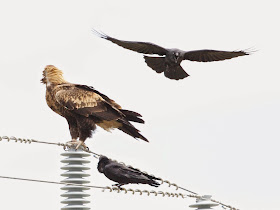We made an early visit to the Twelve
Apostles to avoid the crowds of tourists and look for Rufous Bristlebirds,
which I had seen there on a trip many years ago. They are found in heathland
along the coast from the Murray River mouth in SA to Jan Juc in Victoria. I was
thinking that Bristlebirds at this location may be more approachable for photos
given they are used to the presence of large numbers of people. As it turned
out we did not hear or see any Bristlebirds at the Twelve Apostles or at any of
the other areas where we looked for them that day.
But as we walked towards the various
lookout points for the Apostles we heard a call that sounded like cockatoos,
however it was not exactly familiar. Shortly after hearing the call and as we
stood and took in the grandeur of the coastal cliffs and rock stacks (Apostles)
the mystery of the strange call was solved. Two Long-billed Corellas were
perched on the side of a large rock stack right in front of our lookout point!
 |
| One of the two pairs of Long-billed Corellas seen at the Twelve Apostles perched on a cliff edge. |
 |
| One of the Apostles where we saw the first pair of Long-billed Corellas. |
 |
| 90 degrees from the above photo and looking west along the coast, a view many will recognise, which includes a number of sea stacks - some of the Twelve Apostles. |
As we watched the two birds it became
apparent that one was standing watch while the other was excavating a hole nearby
in the soft rocky material of the stack. To me the bird looked like it was
excavating a nest hollow, but it is possible the bird was seeking clayey
material to ingest as some parrot species do this to rid their systems of
toxins taken in with some foods such as fruits and seeds. We have seen this
behavior in South America.
However in this case the bird was deep in a
hole and given the whole rock stack seemed to consist of the same sand/clay
material it did not make sense that the bird would obtain the soil to eat from
within a hole.
 |
| The Corella on watch while its mate excavated a hole. |
 |
| Long-billed Corella at the hole on a shear face of a sea stack Note the soil on the end of the long bill. |
 |
| Into the hole for another dig. When right in, only the tip of the tail was visible. |
Long-billed and other species of Corella
normally nest in tree hollows and Long-billed usually nest from July to
November, so excavating a hollow in the soft clayey sand of one of the Apostles
rock stacks in late March seemed very unusual indeed.
We left the two to their unusual behavior
and moved to another lookout point some distance away where we found another
pair of Long-billed Corellas. These two were perched in view on a cliff and were
making flights to a section of cliff out of our sight and then returning again
to the same perch. I am not sure what they were up to, however it is possible
these two were also working on a nest hollow. I was pleased when they returned
to the visible perch and I could capture some more photos.
 |
| The second pair of Long-billed Corellas we found at the Twelve Apostles. Note the Starling at the top left of the photo. |
 |
| One of the pair departs for a section of cliff where we could not observe them. |
 |
| The other bird remains perched - but only for a few seconds. |
 |
| The second bird departs to join its mate. The vertical plunge uses gravity to quickly pick up speed. |
There were large numbers of Common
Starlings perched on the cliffs and judging by the numerous holes and crevices
it is likely that they roost and nest on the cliffs.
It would be interesting to hear if anyone
has observed this behavior before or has an explanation or suggestion as to what
the Corella was possibly doing in the hole.
As the saying goes, especially when birding, expect the unexpected.
I never would have expected to find Long-billed Corellas on a Southern Ocean sea cliff.
I never would have expected to find Long-billed Corellas on a Southern Ocean sea cliff.




































